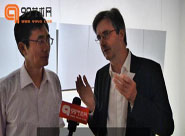landscape,
-3-
but have instead exploited and destroyed it. The art, which had placed landscape signs until the 19th century by creating own artificial and artistic natural worlds within gardens and parks, now resorted to monuments, which seemed to spite Nature rather than wanting to establish a dialogue with It. The American Land-Art Movement of the late 1960s, too, was directed against the concept of landscape, and instrumentalized it as a sparring partner of titanic self-portrayal – doubtlessly with impressive aesthetic results. Admittedly, the Land-Art Movement already carried the seed of another movement. This becomes most clear with the work of Robert Smithson, which illustrates how the small creator, the artist, organizes his sweeping creation within a landscape into the greater Creation of the earth. An example is Smithson’s famous „Spiral Jetty“ inside the Utah Salt Lake.
At the same time the Harrisons, a young, Californian academic couple, both of them landscape architects and artists, began treating Nature according to immanent laws, namely as a set of living organisms organized within a cycle of blooming and withering. The research they initiated and the documentations they created, while claiming to be works of art, served the sole purpose of re-establishing the destroyed natural cycle, to help the environment by the intervention of the ecologically open-minded artist as instigator.
3. The mindscape artist: The image sculptor (Bilder-Hauer) as time-sculptor (Zeit-Hauer)
When the Harrisons, as their kind of ecological artworks, sketch-cum-model the “icon” of the European mountain ranges onto the big maps hanging on their wall, then they absolutely consider themselves to be sculptors.
Regarding the part played by artists such as the Harrisons and Yuan Shun we today recognize the tendency of the ecologically oriented artist to not primarily project themselves as original and individual creators anymore, but instead as keepers of the remaining Nature on this planet, as curators of a newly emerging “sphere of awareness”, as shepherds of the diversity of culture and nature, as ombudsmen of a new alliance between man and nature. Often together with other involved experts of forestry and water management, anthropologists, geo-botanists, landscape architects, the self-determining generalist turns into an initiator and presenter for mankind’s overwhelmingly large, almost unsolvable ecological challenges.
The change in the image of the artist could thus not be more radical. In face of the identity crisis of modernity artists neither want to produce art in an ivory tower nor to practice Agit-Pop attitudes, nor do they want to slip into the part of the aloof prophet and seer, or even apply art in a superficial way as a designer of everyday cultural (Alltagskultur) objects. Instead they wish to act as engineers and builders. Now that the drawbacks of the, parallel to technological and economic expansion, advancing control over nature have been defined as a destruction of nature, a growing number of artists are not seeking their identity within an anthropocentric concept of “genius” (with the artist as augmentation and consummation of Nature), but in an encounter with nature carried by respect, and which leave Her as that which she is, the “other,” that which eludes (human) command.
The revolution of conscience, which has came along with and respectively conditions the epochal findings of brain research, also changes – with a new notion of space and time - the way artists conceive of themselves, their profession, their media. On their “islands of the present,” they shall in future work on time and space as they would on a sculpture.
-4-
The “sculptor of the image” (Bildhauer) here partially becomes the “sculptor of time” (Zeithauer, a term created by the author E. Zorn), and the painter partially turns into an “energy-focuser” (Energiestrom-Fokussierer, ibid.). After the final collapse of exploited Nature it will be the artist who discovers new worlds, new resources of an extended Nature, perhaps within the realm of genetic engineering as a new ambience, which (in turn) is educible within an ecological sociology as a future area of potential artistic activity. However which way – and here “our” artist Yuan Shun differs in the part he plays from the “efforts towards absolutization” of artificial aesthetic performances in a new cyber-high-tech world – the artist involves his/her understanding as an artist in the process, namely as a being that is alive, and mortal as well.
If, then, in a future artistic happening the question of how to feed the world becomes a conceptual artwork, biogenetics turn into material used for landscape painting, when geography and topography may become new guidelines for art history, then it is only logical to continue writing the artistic and scientific achievements of the 20th century in close connection to each other and to postulate an ecological ethic, which amalgamates aesthetic thought and action with scientific though and action. It is also logical to capture in image and writing such models, which vis-à-vis a life-style-oriented art production let their enlightened, action-tried approach converge with the public-social space of action (Handlungsraum) and thus create a performance, which in essence is “art in the public interest.“
4. Yuan Shun’s attack on the virtualization of the artwork
Vanishing, formerly solid, concepts of space and time, i.e. relativizing and, lastly, equalizing (Egalisierung) these spaces and times in the age of electronics and information in favor of unlimited availability and interchangeability of the same space and the same time, not only (to use Paul Virilio’s famous statement) triggered “floods of arguments” within the circles of cultural critics and philosophers. These arguments resulted in a virtualization of (daily) life and public spaces in the age of media (as was proven perhaps most profoundly by the Cologne-based communications scholar Hans Ulrich Reck). Yet, what is most remarkable about these shifts of time and space is the substantial resistance, which they generated among artists, especially in regard to the elimination of the identity of space and time. With and within their artworks did these artists assure themselves of the respective spaces and times they stated and then made their own, turned them into art spaces, that is, spaces which they archived in order to try and bring them to life, like the Dutchman Herman de Vries or Joseph Beuys with his placing of 7000 oaks and stones – art and nature in equal alliance. The Milan-based Austrian painter and illustrator Helmut Schober sought out his current method from within the Performance and Happening Movement of the 1960s and 70s, and by – without any computer-aided devices – applying layers of graphite onto the canvas and then shaping them with a brush made possible fantastic journeys of the eye into the cosmos of light and color. These in a way are journeys into the infinity of the micro- and the macrocosm and by far exceed the tricks and illusions created by the cyberspace-trips of computed spaces.
Yuan Shun’s approach is to merge the relics and signs of Nature into canyons and signs of Civilization to bizarre habitats and trenched expanses in archaic-futuristic shapes and mental constructs (“Denkfigur”), to “Scapes of (the) Mind.“ This is a process, which is constructed via conventional means and fixed by photography, and specifically because of its insistence on outdated traditions of art production provokes in the observer such intense fantasies. These fantasies, in turn, fundamentally differ from those triggered by electronic media with their use of virtualized images because of the underlying assertion of the human perspective on the artist’s part.
The camera lens is a device controlled specifically by the human eye, and an adequate means for it to perceive the world, shape the world, and lay out the “Mind-scape.” The moment (Augenblick), which the camera captures of the artistic construct (and here I only wish to address the conventional camera), does actually not signify much if compared to myriads of other moments (Augenblicke). It does not mark any distinctive and recognizable place, nor does it unmistakably denominate a time or a cultural situation, and initially seems – in its placement of signs (Zeichensetzung) – close to the metaphorical language (Bildersprache), with which we are familiar through the daily media brainwash. It nevertheless manages to create a value, which may be considered to be fundamentally human. Among the un-places, the un-times, the endeavor to orientate, to set a pattern becomes apparent in the moment of photographic exposure. In the end, all this may really be about is Utopia.
Such composition is much more difficult than fleeing into idyll, i.e. the “comfort-places” (“Trostorte”) of lifestyle. That Yuan Shun was able to, by using only few means, enter into the phalanx of the speciousness of the picture industry undeniably signifies an attack on precisely that industry. Yuan Shun dares to travel this rocky road, and in my opinion does so with excellence. He thus aligns himself with the historically most significant artists of landscape imaging (Landschaftsabbildung) as reflection between man and Nature – from the “beautiful place” of the Greeks and Romans, from the “fullness-of-self” (“Seinserfülltheit”) of ritual Chinese landscape painting from its beginnings to the 19th century, from the advent of European modernity in perspective painting (Perspektivenmalerei) of the Italian Renaissance via German Romanticism to French Impressionism and the collective European Expressionism, and ultimately to predominantly Italian and Russian Futurism. Present in the part of the performer, of the artist, Yuan Shun zooms nature over, retrieves her from the/his (still central) human perspective. Yuan Shun’s works act as part of this long tradition of artistic landscape visualizations, and signify this tradition’s temporary end. As the reformer and cultural founder Martin Luther put it in his famous posit: “And if I knew that the world ended tomorrow, I would plant my little tree this very day.”
If we compare Yuan Shun’s substantial models with commonplace tendencies towards virtualization, also as relates to art production, then this does not mean that the artist does not reflect and treat the worlds of virtual reality. In his statement to „‚Mindscape‘ project 2003-2004“ he views his models as observation wards and actions of virtual reality fighting for nature, fighting crimes against the environment – even if they are “only” very concrete, physical signals claiming a global ecological message.

